#plant post
Text
Anyone else a plant parent?:D🌱🌳🌿

#witchblr#witchcraft#witch#baby witch#witch community#magic#magick#plants#plant mom#plant dad#plantblr#witchcraft community#herbal witch#nature#plant#plant post
114 notes
·
View notes
Text

Plant Post
My little marigold shoots are starting to get their spiky leaves!!
18 notes
·
View notes
Text

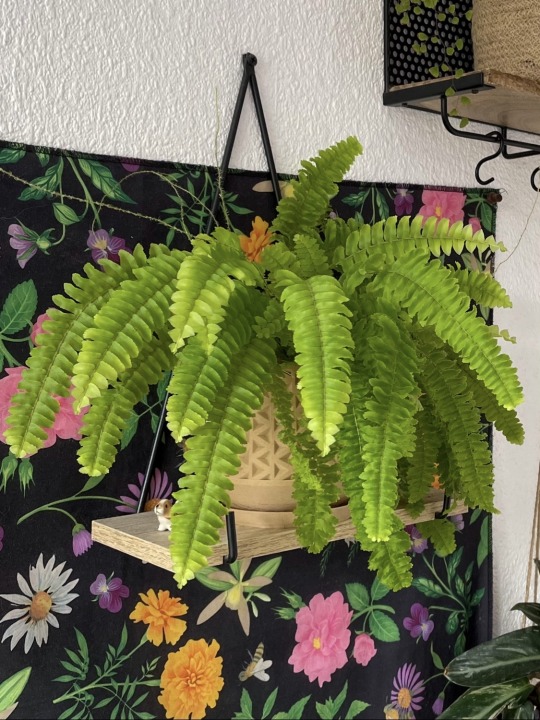
bro the glow up my boston fern has had..
24 notes
·
View notes
Text
What's everyone's favourite flowers that aren't like. The normal ones. Like everyone's a fan of roses and sunflowers what's a more niche one. One you don't get in gift sets. Mine's sweet peas
#other good ones are crocuses and lilacs#one time I was ill and depressed and my mum brought me a lil milk bottle full of fresh cut sweet peas from her garden 💖#i like that theyre colourful and i like climbing plants and they smell amazing#posts brought to you by me going to the park on my lunch break just to see all the crocuses
35K notes
·
View notes
Text
"A century of gradual reforestation across the American East and Southeast has kept the region cooler than it otherwise would have become, a new study shows.
The pioneering study of progress shows how the last 25 years of accelerated reforestation around the world might significantly pay off in the second half of the 21st century.
Using a variety of calculative methods and estimations based on satellite and temperature data from weather stations, the authors determined that forests in the eastern United States cool the land surface by 1.8 – 3.6°F annually compared to nearby grasslands and croplands, with the strongest effect seen in summer, when cooling amounts to 3.6 – 9°F.
The younger the forest, the more this cooling effect was detected, with forest trees between 20 and 40 years old offering the coolest temperatures underneath.
“The reforestation has been remarkable and we have shown this has translated into the surrounding air temperature,” Mallory Barnes, an environmental scientist at Indiana University who led the research, told The Guardian.
“Moving forward, we need to think about tree planting not just as a way to absorb carbon dioxide but also the cooling effects in adapting for climate change, to help cities be resilient against these very hot temperatures.”
The cooling of the land surface affected the air near ground level as well, with a stepwise reduction in heat linked to reductions in near-surface air temps.
“Analyses of historical land cover and air temperature trends showed that the cooling benefits of reforestation extend across the landscape,” the authors write. “Locations surrounded by reforestation were up to 1.8°F cooler than neighboring locations that did not undergo land cover change, and areas dominated by regrowing forests were associated with cooling temperature trends in much of the Eastern United States.”
By the 1930s, forest cover loss in the eastern states like the Carolinas and Mississippi had stopped, as the descendants of European settlers moved in greater and greater numbers into cities and marginal agricultural land was abandoned.
The Civilian Conservation Corps undertook large replanting efforts of forests that had been cleared, and this is believed to be what is causing the lower average temperatures observed in the study data.
However, the authors note that other causes, like more sophisticated crop irrigation and increases in airborne pollutants that block incoming sunlight, may have also contributed to the lowering of temperatures over time. They also note that tree planting might not always produce this effect, such as in the boreal zone where increases in trees are linked with increases in humidity that way raise average temperatures."
-via Good News Network, February 20, 2024
#trees#forests#reforestation#tree planting#global warming#climate change#climate crisis#american south#the south#eastern us#southern usa#conservation#meteorology#global temperature#conservation news#climate news#environment#hope#good news#hope posting#climate action#climate science#climate catastrophe#climate hope
13K notes
·
View notes
Text

Plants
#trigun#vash#vash the stampede#tristamp#trigun vash#trigun stampede#THE RARE FANART#guess who caught up with the series#plants#digital art#the fanart tag#there is a knives version posted separately
13K notes
·
View notes
Text
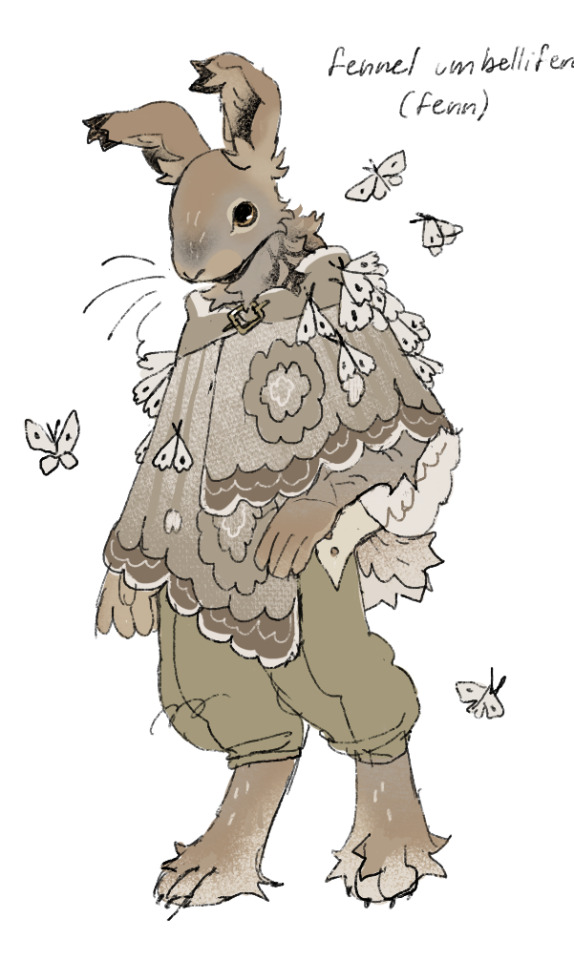
drew up a pretty quick design for a harengon swarmkeeper ranger/rogue for a oneshot i'm playing this weekend ♡ their name is fennel and they go by fenn (they think it sounds much cooler)
#art#ID in alt text#furry#d&d#d&d art#harengon#perhaps i'll dig up the old umbel family art i did a while ago to post here. i think you all would like it#this lil dude's whole family is named after parsley family plants#actually maybe i should even.. redraw them.. i like them a lot
11K notes
·
View notes
Text
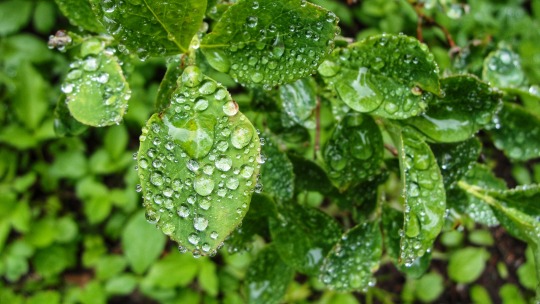


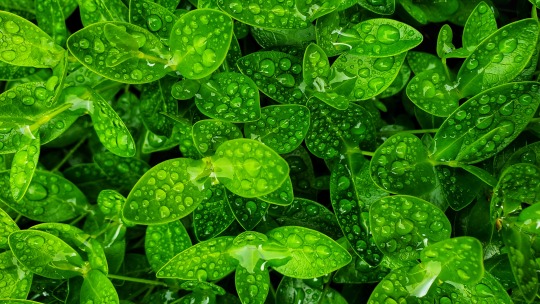

water droplets on greenery
#photography#macrophotography#macro#macro photography#my post#greenery#plants#foliage#i tried to put together a#gradient#i believe it was a success#nature#nature photography
4K notes
·
View notes
Text








#cozy kitchen#cozycore#cozy room#cozy aesthetic#cozy vibes#cat#aesthetic#flowers#nature#flowercore#not my photo#cottagecore#cottage vibes#cottage core#cottage aesthetic#maximalist aesthetic#maximalist style#maximalist decor#pink#pink aesthetic#plantblr#plantcore#plants#booksbooksbooks#book#bookblr#booklover#books#kitchen#my post
4K notes
·
View notes
Text
The knowledge of some common plants
Since many people don't know most of the plants around them, this is information on some plants that are commonly seen in many places throughout the world

This is Lamium purpureum, also called Purple Deadnettle.
It's called deadnettle because it looks like a nettle but it doesn't sting you
This plant is a winter annual—it grows its leaves in the fall, lasts through the winter, and blooms and dies in the spring
Its pollen is reddish orange. If you see bees with their heads stained reddish orange, it is likely because they have visited Purple Deadnettle
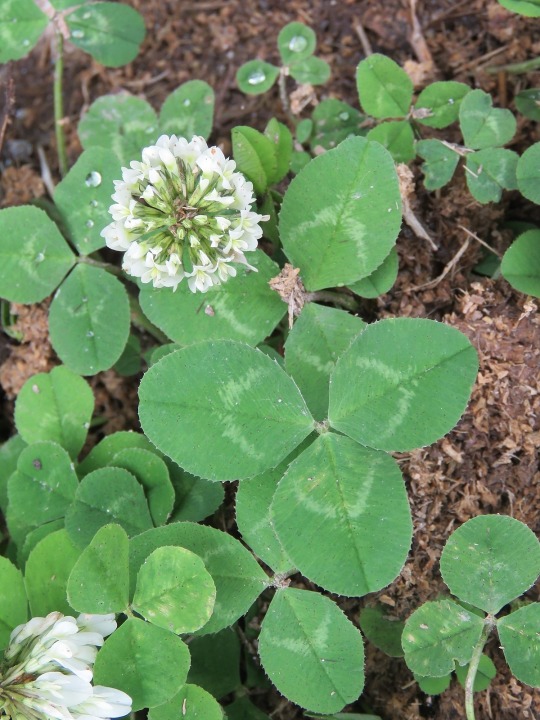
This is Trifolium repens, white clover
It is a legume (belongs to the bean family) and fixes nitrogen using symbiosis with bacteria that live in little nodules on its roots, fertilizing the soil
It is a good companion plant for the other members of a lawn or garden since it is tough, adaptable, and improves soil quality. According to my professor it used to be in lawn mixes, until chemical companies wanted to sell a new herbicide that would kill broadleaved plants and spare grass, and it was slandered as a weed :(
It is native only to Europe and Central Asia, but in the lawns they are doing more good than harm most places
Honeybees love to visit clover
Four-leaf clovers are said to be lucky
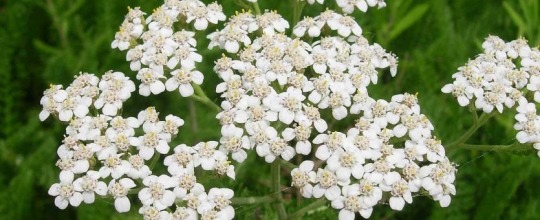
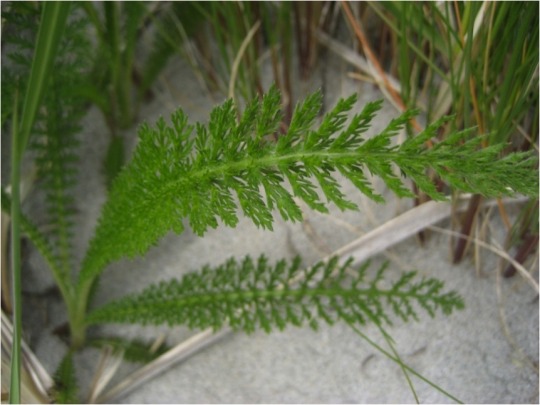
This is Achillea millefolium, Common Yarrow
It has had a relationship with humans since Neanderthals were around, at least 60,000 years, since Neanderthals have been found buried with Yarrow
Its leaves have been used to stop bleeding throughout history, and its scientific name comes from how Achilles was said to have used Yarrow to stop the blood from the wounds of his soldiers. A leaf rolled into a ball has been used to stop nosebleeds
It is a native species all throughout Eurasia and North America

This is Cichorium intybus, known as Chicory
The leaves look a lot like dandelion leaves, until in mid-spring when it begins growing a woody green stem straight up into the air
Like many other weeds, it has a symbiotic relationship with humans, existing in a mix of domesticated or partially domesticated and wild populations
It is native to Eurasia, but widespread in North America on roadsides and disturbed places, where it descended from cultivated plants
Its root contains large amounts of inulin, which is used as a sweetener and fiber supplement (if you look at the ingredients on the granola bars that have extra fiber, they usually are partly made of chicory root) and has also been used as a coffee substitute
A large variety of bees like to feed upon it

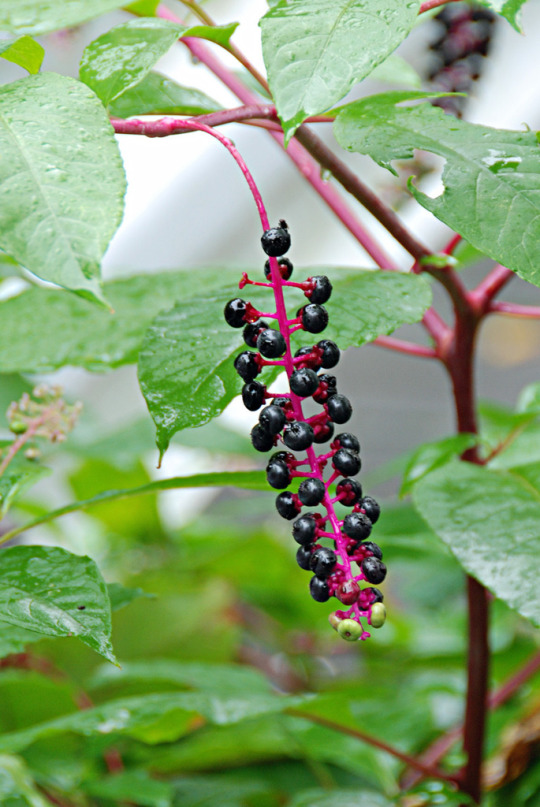
This is Phytolacca americana, known as Pokeweed
It is easily identified by its huge leaves and its waxy, bright magenta stem
It can grow more than nine feet tall from a sprout in a single summer!
If you squish the berries, the juice inside is a shocking magenta that is so bright it almost burns your eyes. For this reason many Native American people used it for pink and purple dye.
It is a heavy metal hyperaccumulator, particularly good for removing cadmium from the soil
All parts of the plant are poisonous and will make you very sick if you eat them, however if the leaves are picked when very young and boiled 3 times, changing out the water each time, they can be eaten, and this is a traditional food in the rural American Southeast, but I don't want to chance it
British people have introduced it as a pretty, exotic ornamental plant. I think that is very funny considering that here it is a weed associated with places where poor people live, but maybe they're right and I need to look closer to see the beauty.
If you see magenta stains in bird poop it is because they ate pokeweed berries- birds can safely eat the berries whereas humans cannot

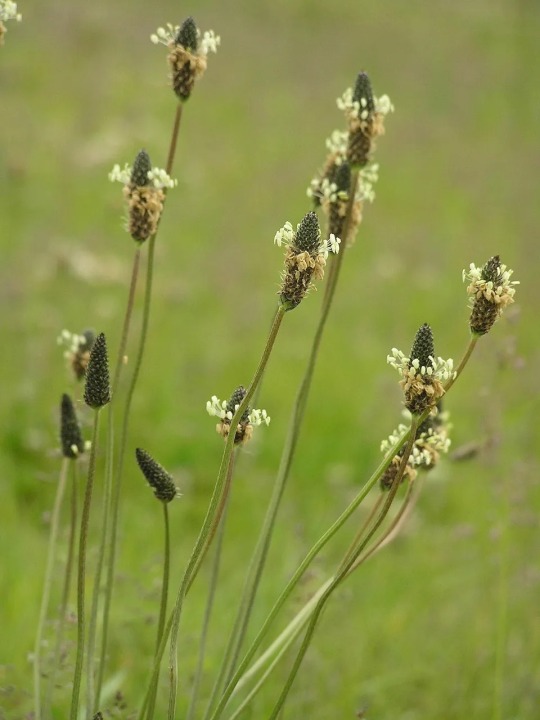
This is Plantago lanceolata, Ribwort Plantain
It grows in heavily disturbed soils, in fact it is considered an indicator of agricultural activity. It is successful in the poorest, heaviest and most compacted soil.
The leaves, seeds, and flower heads are said to be edible but the leaves are really stringy unless they are very young. Of course, it is important to be careful when eating wild plants, and make sure you have identified the plant correctly and the soil is not contaminated
I have also heard the strings in the leaves can be extracted and used for textile purposes
and that's some common plants you might often see throughout the world
#just remembered i had this in my drafts#i forget why i didn't post it immediately#anyway#plants#the ways of the plants
5K notes
·
View notes
Text
Sometimes it’s hard to read fanfic when you’re studying herbalism.. when they have the character preparing a tincture to use that same DAY!!?
Baby those dried herbs need to sit in that jar with high proof alcohol for at LEAST a month!
That’s why before the use of calendars ppl use to prepare their tinctures either on the new moon or full moon. A a full moon cycle is usually 28 days or so. And they would give the moon names so it’s easier to remember when/what month said tincture was bottled.
This is also why herbal medicine is prepare in small batches. You have to take your time preparing your bottles. Making sure everything is clean so you don’t end up with mold. Diluting your grain alcohol. Heckkk knowing when to pick your herbs for max potency! Drying your herbs! That takes a lot of time too!
I didn’t mean to rant lol
#herbalism#I just wanna swoop in there and be like hey hey hey wait hey#do we need writing resources about herbs? cause that’s coming up#I don’t wanna just post random info about plants#I hope like… it’s useful even in a creative sense?#pee usual Im overcomplicating a project lol#ramble
4K notes
·
View notes
Text
As promised, welcome to
Fun biology in TOTK’s designs
I'll keep this post updated as I go through the game. I'm going to skip the more general identifiable things like apples (they're based on apples!) because there are tons of more unusual species to talk about.
Overall, the really interesting thing I've noticed is that many of the more unique Earth-based lifeforms in TOTK are super ancient, like predating dinosaurs ancient, which is a really cool tie-in to the overall time-hopping plotline of TOTK. Specifically, they're found in the new areas (caves, depths) while the surface remains a bit more normal.
(There will be no plot spoilers in this post, and also I've barely gotten into the plot because I'm spending all my time wandering, so shhh no spoilers in the tags for like a month please.)
Most recent additions: More lilies, irises, wild ginger, spiny bones, pigeon extravaganza, plus added some more real photo comparisons to old stuff.
PLANTS
Bryophytes my beloved. Bryophytes are among the earliest land plants, waaaay predating flowers and even seeds. In our world, they’re small by necessity—they lack vascular systems to help move water around like other plants, so they have to stay small and moist (hence their frequency in caves in TOTK—though they do need some light in real life.)
In TOTK they’re quite large and I think that’s very sexy and art directors should give us big bryophytes more often
Anyway, there are three types of bryophytes: mosses, liverworts, and hornworts. First image pair is a moss, second is a liverwort. Those red-brown and palm-tree-like structures, respectively, are their reproductive structures.
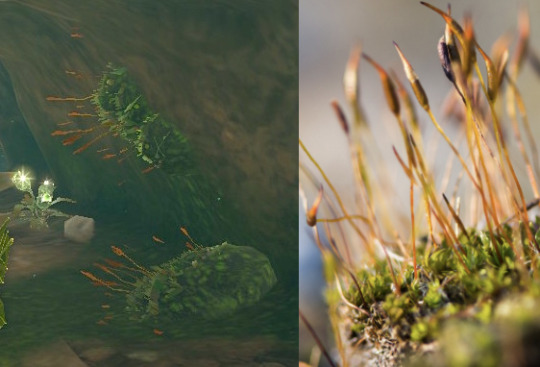

Real liverwort photo © Graham Calow, NatureSpotUK
Not yet spotted: Hornworts! Did they forget the third bryophyte sister :(
I think these next guys are probably lycopods (specifically club moss, which is not a true bryophyte moss, thanks science.) Very old, but vascular, so they're a bit more evolutionarily recent than bryophytes.

Real photo © Gloria Hanley Schoenholtz, virginiawildflowers
All the enormous curly-topped trees in the depths: Ferns! They curl like that until they unfurl. Another very old plant, though younger than bryophytes and lycopods.
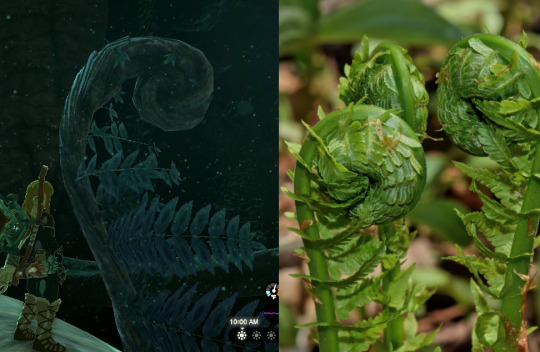
Real photo via The Cosmonaut, Wikipedia
Brightblooms and some of the other giant plants in the depths: Possibly based on a cycad? Again, a very ancient plant lineage. At this point, evolutionarily, they've developed seeds—that giant cone in the center is called a strobilus, and that's the seed structure.
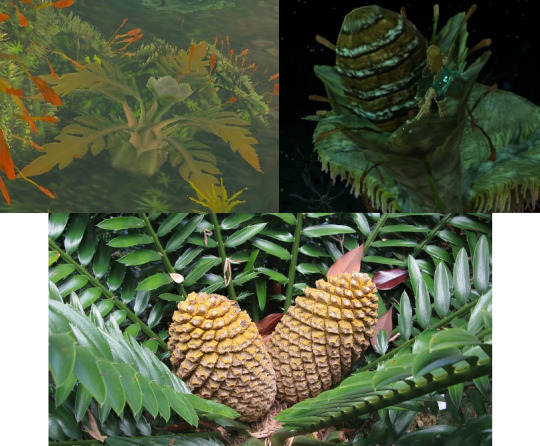
These next few plants are angiosperms, meaning they produce flowers. Angiosperms are a more recent evolutionary lineage—still many millions of years old, but it took a while to develop flowers as a reproductive tactic.
Sundelions (left) are a fun recolor of a lily. There are also some scenery lilies (right) in various places—there are yellow ones that spring up when you turn on a lightroot (which gives them literal and thematic connection to the surface) and several other varieties, including tiger lilies, throughout Hyrule. Fun note, the sundelions appear to only have 5 stamen, while other lilies in the game (correctly) have 6. Seems to be an intentional decision to make it a more distinct fantasy species.
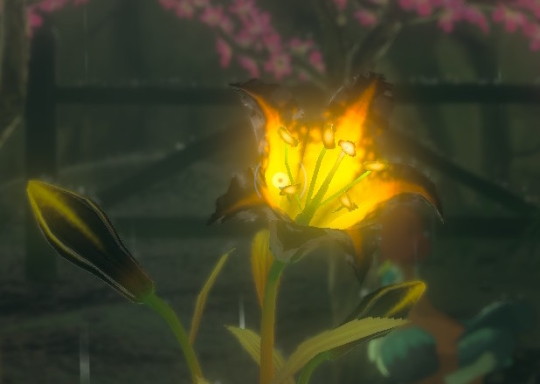
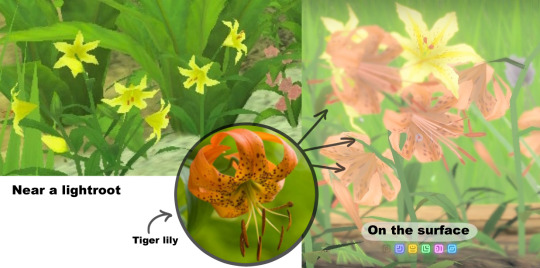
These next ones are Peruvian lilies/Alstroemeria, just used as a scenery plant but a very fun inclusion. Fun fact, not true lilies, so they're not deadly to cats like true lilies are.

Real photo © Dick Culbert, Wikipedia
Plum trees: These are also called out as plum trees in game! There's a journal in Kakariko that refers to the plum orchards.

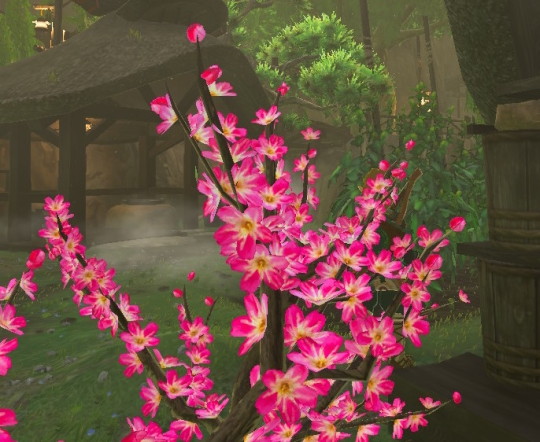
Okay I'm a little proud of figuring this one out. Bomb flowers blend a few botanical references. Superficially, the fruit resembles a type of seed pod called a capsule—specifically it's very similar to a poppy capsule. The little red thing in the center is a nice addition to resemble both a flower stigma (reproductive part that leads to the ovary) and a bomb fuse. Now, poppy capsules disperse their seeds via wind, but there are other plants who do explode their seeds outwards as a dispersal tactic! This is called explosive dehiscence.
There is one tree in particular called the sandbox tree, AKA monkey-no-climb or dynamite tree (yes, really.) Their capsules look more like little pumpkins, but are known for violently exploding when ripe—they can launch seeds at 150 miles per hour (250 km/h) and spread them roughly 200 feet (60 m) away. The photo comparison is a poppy capsule but you should def go look up dynamite tree videos.
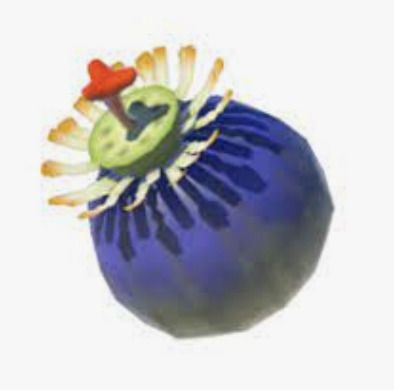
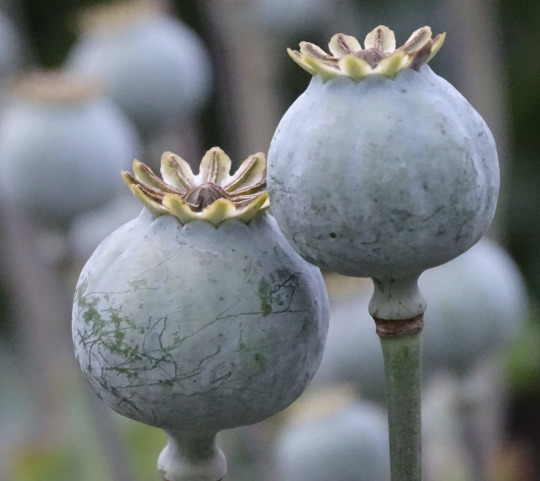
Real photo © PommeGrenade, pixabay
Fire fruits (and the other elemental fruits) grow on the same generic plant that looks kind of like it has grape leaves. Fire fruits resemble a specific botanical thing too though—the black netting is a papery calyx (part of the flower) seen in a nightshade genus, Physalis (golden berries, tomatillos, etc.)


Real photo © Helene Rogers, Alamy
I think this stuff is an Asarum, AKA wild ginger. I was actually puzzling over it until I walked past some today and went HEY
Not sure of the exact species but they're very green and heart-shaped and love being dense and low to the ground.
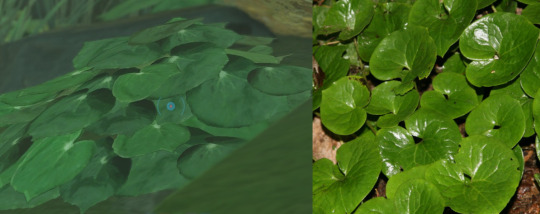
Real photo via David Stang, Wikipedia
Irises: Love irises, one of my favorite flowers and words, very happy to see them in game.

MISCELLANEA
Cup lichen! Lichen is not a plant, but a symbiotic structure of an algae + a fungi. Cup lichen is just a type of lichen formation that has a kind of vertical cup-like structure.
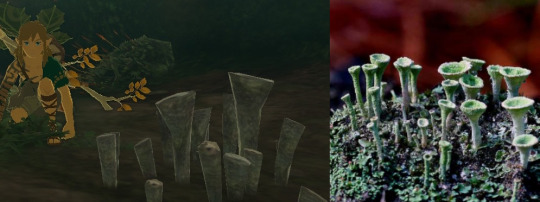
Real photo via Bernard Spragg
Geology crossover! Go look carefully at some of the whiter walls in the depths—they look like they have fossils of coral and other undersea hard-structured animals in them.
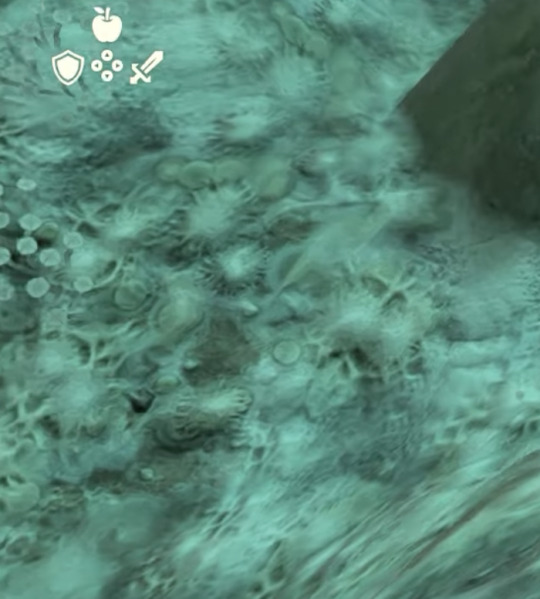
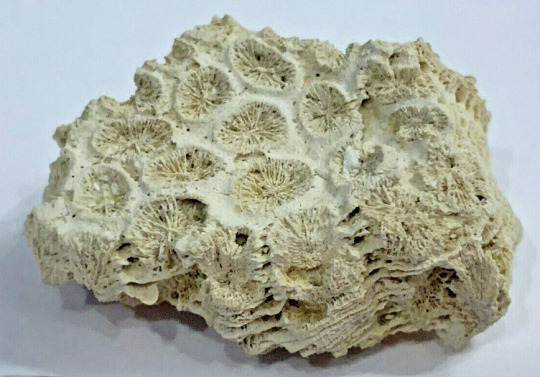
ANIMALS
Sticky lizards: Based on Diplocaulus, a very early (now extinct) amphibian! Their skulls are wacky. We're not sure whether the long sides stood out separately or were smoothly connected to the body by skin flaps, but the separate arrow-like shape is the most popular rendition.
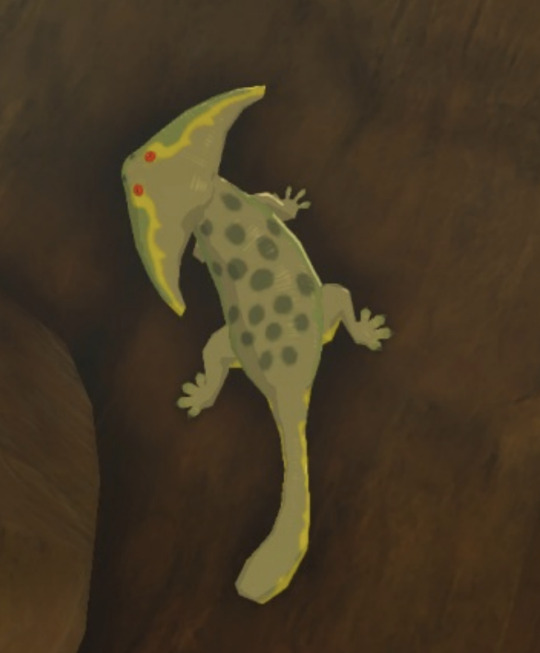

Deep firefly: Might be a stretch because it could just be a multi-winged fantasy critter, but I think the "wings" and antennae are very reminiscent of Anomalocaris, an ancient aquatic arthropod.
Update: Other folks in the notes/tags have pointed out that they're probably based on a cryptid that's especially popular in Japan: skyfish AKA rods! They show up in photos and people think they're an alien lifeform. In reality, they're an optical blur created when a lower quality video captures intermittent flaps of an insect's wings, leaving sort of a many-winged smear in the photo. Thanks to all who left info!
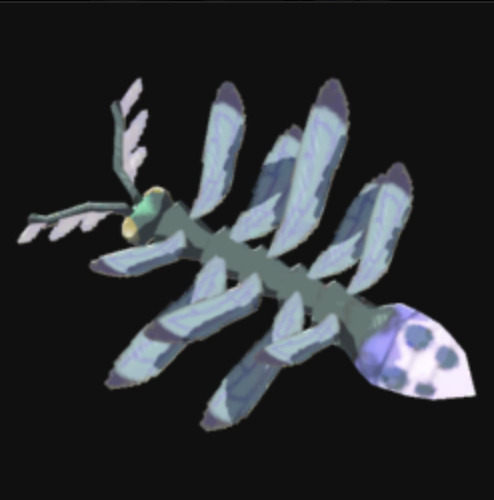
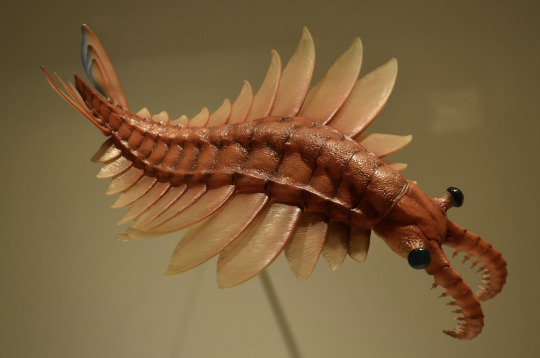

Little frox: Another stretch because it totally could just be a Hinox-like frog, but every time I see the little ones I can't help but think of like...Ichthyostega, Mastodonsaurus, Eryops, and other early amphibians. They were pretty hefty—little frox size or bigger—and had with little waddling legs. This is less "I think it's definitely this" and more "it makes me happy when I picture frox as primitive amphibians."


I haven't detailed many of the scenery animals around Hyrule because most are identifiable with the camera function—it'll tell you that a certain animal is a heron or porgy, for example, and those groups are real, even though the exact species is made up. But I think the pigeons are fun because they're all crested pigeons. Pink-necked green pigeons may have also been the inspiration for the color palettes on the wood and rainbow pigeons.
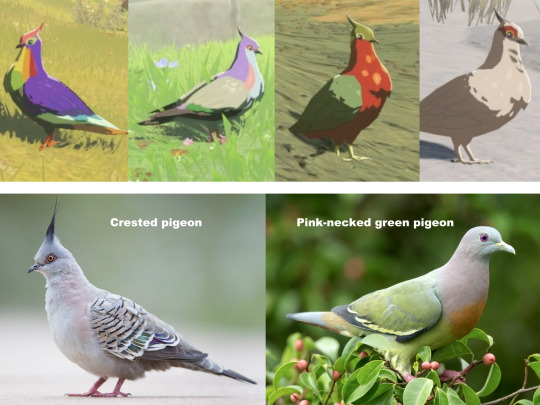
Both pigeon photos via JJ Harrison, Wikipedia
Spiny bones: Not a specific critter, but those spiny bones that you can find lying around Eldin Canyon are vertebrae—possibly from the same thing that left those big rib cages around? The top spike is the spinous process where muscles attach, the littler spikes on the side are the transverse and articular processes. The dark O in the center is the spinal cord.
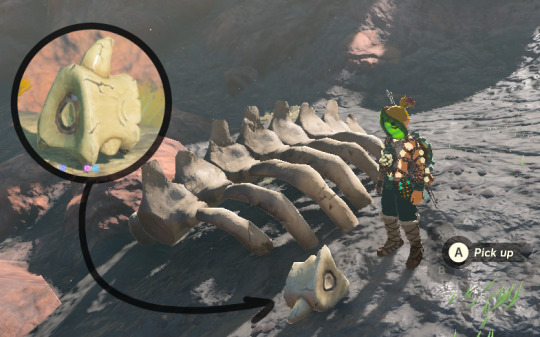
Also I made a friend who finally recognizes my purpose in Hyrule.

That's all I've got for now! Will add more as I keep playing.
#tears of the kingdom#totk#legend of zelda#loz#science fun#biology#lizard#plant#botany#image heavy#long post
7K notes
·
View notes
Text

Average un-symbiosed Leafwing.
There are actually two types of leafwings, variants if you will. "Living Gardens" and "Walking Plants". This post is about the Living Garden variant.
At heart, Gardens are just that, gardens. They on average look like sticks or peculiar driftwood, and throughout their life have plants growing on them. It starts young where they have the highest chances of a complete symbiosis with a plant, When a Garden first symbioses with a plant, usually only ever one species of plant for their whole lifetime (things can get messy if there's multiple species on one dragon, the plants basically fighting each other for real-estate on the dragon). Vines and trees are by far the easiest for a Garden to symbiose with, with carnivorous plants being the hardest.
Garden families have traditions of keeping the "Family plant", with each generation either symbiosing with the same plant as their parents or the same general species.
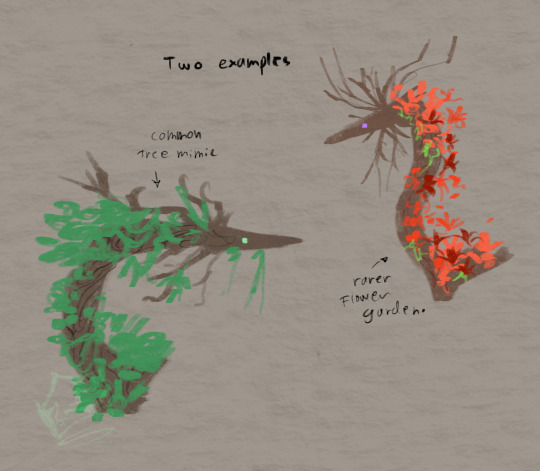
#Hopefully this all makes sense and isn't too convoluted.#I'll make a Walking Plant post later but that one is pretty obvious on what it is.#my art#wof#wings of fire#wof fanart#wof leafwing#leafwing#dragon#dragon art#art#artwork#creature#creature art#[HEADCANONS]
2K notes
·
View notes
Text

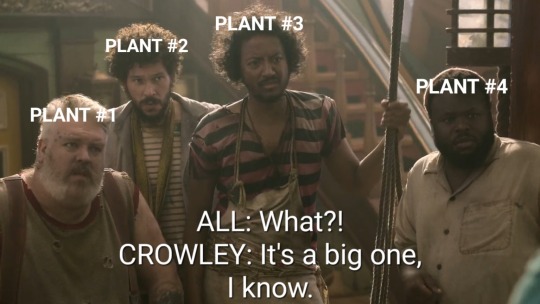





#i think the bentley loved her little road trip 💛#and i needed a fun post to break up the heartbreak lmao#the plants are like STFU GOLDEN CHILD DON'T PISS HIM OFF#Good omens#good omens spoilers#good omens season 2#good omens season 2 spoilers#good omens 2#good omens 2 spoilers#gos#gos spoilers#gos2#gos2 spoilers#gomens#gomens spoilers#gomens 2#gomens 2 spoilers#good omens s2 spoilers#ineffable husbands#aziracrow#aziraphale#crowley#mine#ofmd#our flag means death#meme#bentley#the bentley#ineffeble divorcees#crowley's plants
4K notes
·
View notes
Text
WARNINGS / FAQ / REQUESTS
asks are open! check here before sending :) (updated 3/10/24)
banned from BLAST for being too sexy
CREATURE WARNING:
this blog posts BEASTIES and ORGANISMS. if you are uncomfortable with seeing any manner of organism (spiders, rodents, fish, etc) please block the tags for that organism before following/browsing.
for broad categories: i tag in plurals (insects, bugs, fish, rodents, parasites, pathogens, plants, trees, etc.)for specific organisms: i tag in singulars (dobsonfly, eurasian harvest mouse, etc.)
for disease causing bacteria: i tag the illness it causes (malaria, botulism, etc.)
ADDITIONAL BUG WARNING: this blog posts a LOT of insects, especially moths.
FOR SCREENREADER USERS: by the nature of this blog, 99% of my posts will have large sections of unformatted letters, and therefore aren't very screenreader friendly.
If I ever miss a tag or you'd like to request that I tag something, please send me a message.
FREQUENTLY ASKED QUESTIONS:
Are you a bot?:
no, just neurodivergent
How do you do this?:
i delete everything in a message except for the letters A, T, C, and G. then, i BLAST it with my wizard beams.
Are you Italian?:
my lawyer has advised me not to answer this question
How do I request things?:
read the REQUESTS section of this post :)
Why are there so many bugs???:
1. insects make up almost 80% of all animal life on earth
2. they are relatively easy to study, so there's more bug DNA in the BLAST database.
Okay but why so many MOTHS???:
because scientists are not immune to bias. moths are pretty looking and easy to study, so there is more moth DNA in the BLAST database.
Do the punctuation marks/emojis mean anything to BLAST?:
no, i just keep them there after my first pass of a text so you can easily recognize i'm using that same text to find an organism.
Can I send in general questions?:
yes! but they may get BLASTed.
REQUESTS:
to request something, please read this section and then send an ask.
asks that don't follow these guidelines will be deleted, and may get you blocked.
For questions: make sure it hasn't been already answered in the FAQ, then send.
For songs, poetry, bible verses, or otherwise long text (over 1500 characters, or text with a lot of spacing): send a link to the text or a pastebin with the text in it.
For Tumblr posts: send a link.
For other languages: make sure it's romanized (in latin script), then send.
REQUESTS I WILL NOT ANSWER:
things i have already answered. search the blog for whatever you're about to submit, and check the Frequently Requested section before sending.
private information (name, address, etc. YES people have tried this.)
images (including images in your text is fine, as long as there's enough text that i can search with it)
AAAAAAAAAAA, GATCAGTCAGATTCCGACGGT, CATCATCATCAT, etc. get creative with it.
spam. you only have to send a request once.
homestuck
FREQUENTLY REQUESTED:
The Bee Movie Script, navy seals copypasta, AM hate monologue, All Star, Yoshikage Kira, Never Gonna Give You Up, man door hand hook car door, Big Bill Hells, FNAF Connection Terminated, JURGEN LEITNER, Eggman's Announcement, Free Bird, Spiders Georg, Weed Smoking Girlfriends, Ebony Dark'ness Dementia Raven Way, Minos Prime, Steamed Hams, (this list will be updated as we go!)
thank you for reading! as a treat, enjoy this Strelitzia reginae, or Birds of Paradise flower. :)
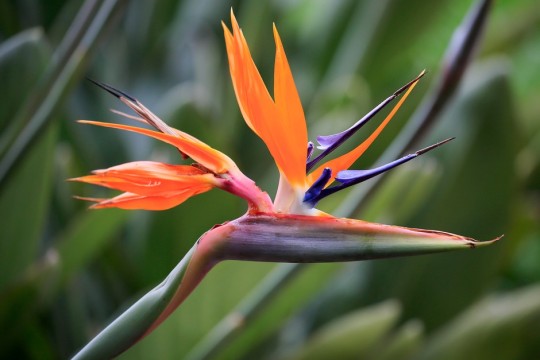
#hellsitegenetics#faq#intro post#flowers#plants#requests#birds of paradise#asks#remember to keep checking back!
1K notes
·
View notes
Text
I think it's so adorable that early humans took wild gourds - a tiny fruit that hollows out as it dries, making it float - and decided to make something out of it

they thought the tiny fruit was so good that they bred it for thousands of years, making it larger to form into bowls and cups, and different shapes to become bottles and spoons

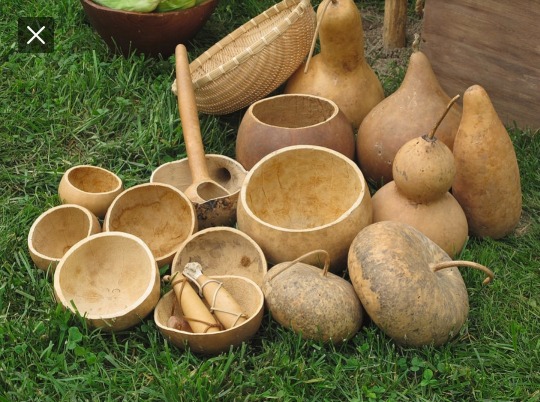
and musical instruments
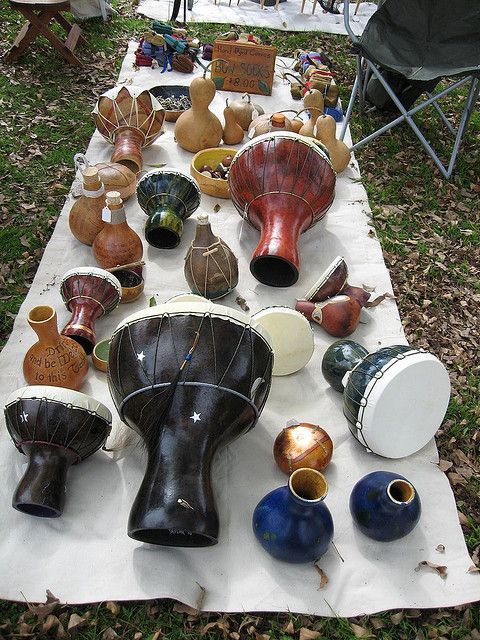

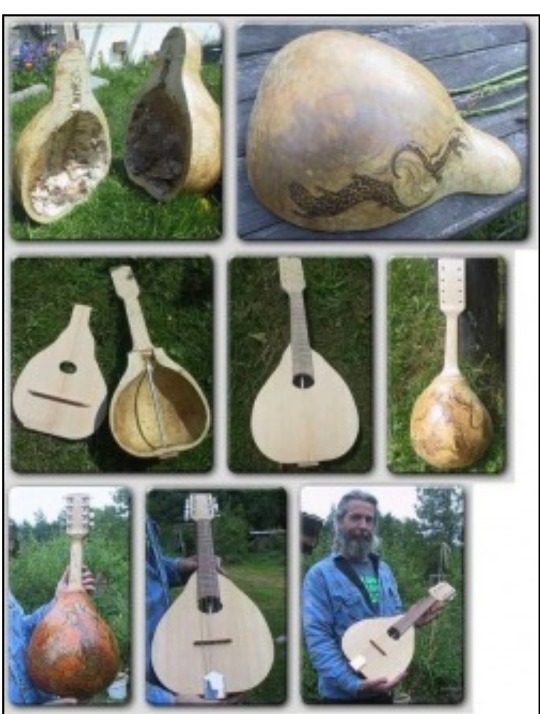
And then, people took the hollow gourds they farmed, and they turned them into houses for birds. We adapted them into the perfect houses for birds, and now there are specific breeds of birdhouse gourd just for making into birdhouses

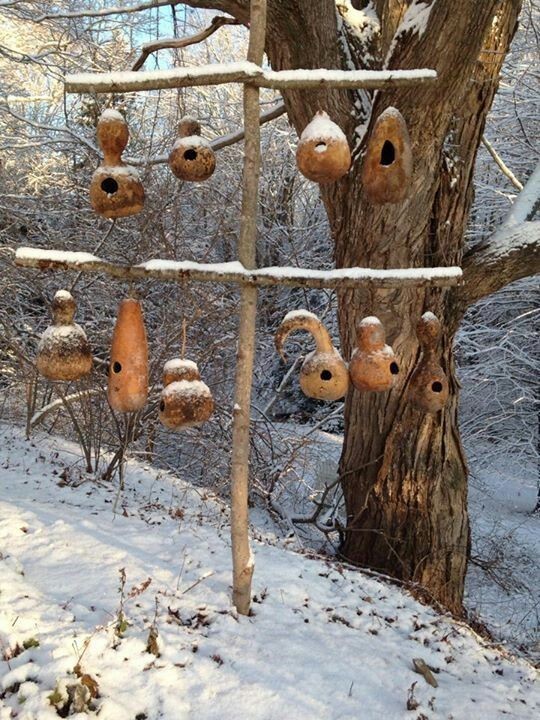
And humans dedicated gardening space and time and thousands of years of breeding to make the gourds so absolutely perfect for birds, that there is a species of bird that lives almost exclusively in them
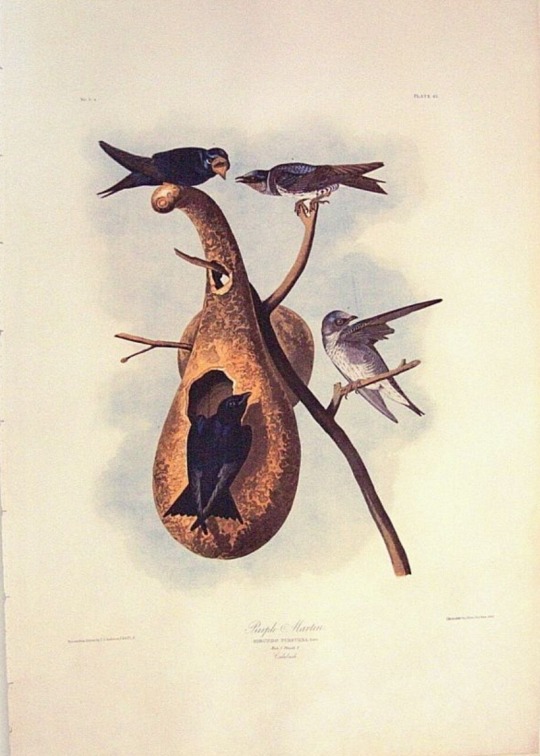
#yes I KNOW i posted about this the other day but *crying* i just love plant domestication and the history of agriculture#and humanity's positive affect on the ecosystems we live in#mine#image IDs in alt text#hmm. I'm gonna tag this#permaculture#just to pspsps @ that community to look at how cool gourds are please everyone grow birdhouse gourds and give cavity nesters places to live#i don't think mine will become fully ripe before i get my first frost :( next year i need to start gourds indoors#i didn't want to grow them before because i didn't have much garden space but now i do and i need to grow all of them#i might be. a little obsessed with gourds. but also i saw a pair of purple martins flying by the road last year#and i had never seen one before then! and i need to see more of them#i have a few hundred barn swallows but i need more birds flying around my house. more!!#and also i have a ton of invasive cavity nesting species around here. house sparrows and starlings.#gotta make up for those things competing with native birds for nest dites#*sites#the invasive birds very often win :/#that's why they're invasive#i really do need to start trapping them....
31K notes
·
View notes